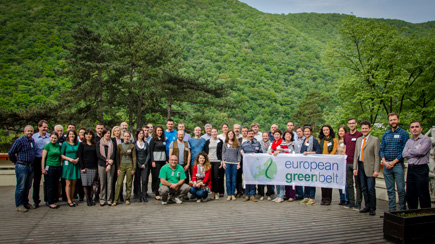
50 participants met in the "Balkan Green Belt" Regional Conference in Romania.
© Felix CybullaLife-line in place of the former Iron Curtain +++ Gaps in the Balkan Green Belt +++ Border fences break connections in nature and between people
Press Release, 18 April 2016
Radolfzell. The Green Belt in Europe stands above all for one thing: connection. It reaches across 12.500 kilometres as a corridor of habitats with exceptional species diversity along the former border between East and West from the Barents Sea to the Black Sea. From 13th to 16th April 2016 50 participants from altogether 13 European countries met in Băile Herculane, Romania to strengthen the green spine of our continent. Central focus was the southernmost section of the most extensive biotope complex world-wide, the Balkan Green Belt.
All the most important actors and decision makers met at the conference to exchange experience. The event was organised by the European Nature Foundation EuroNatur and IUCN (International Union for Conservation of Nature) and financially supported by the German Federal Environmental Foundation. In its conclusions it emphatically underlined the position of the Balkan Green Belt as a key element for the protection of biodiversity in Europe and pointed out that of all places the belt shows alarming gaps.
The Lesser White-fronted Goose is an illuminating example. It is one of the European birds most threatened with extinction. Important breeding grounds lie in the northernmost area of the Green Belt of Europe in the Fennoscandia section and the birds are protected there in exemplary fashion. But a large proportion of their resting and wintering places lie in the Balkan Green Belt – and there the birds are far from safe. One of the most important is Labudovo Okno in Serbia close to the Romanian border. The Danube flows through in a wide river bed offering waterbirds such as the Lesser White-fronted Goose ideal places to rest and this is where bird hunters pursue their dire activities.
“Our aim,” Gabriel Schwaderer said, “is to make the European Green Belt a habitat corridor protecting the most important biotopes and connecting them up. Everywhere where connectivity is destroyed or impaired it must be restored. The conference has strengthened the necessary network of actors. Above all the regional NGOs have received valuable impulses to align their activities with the idea of the European Green Belt, to think across borders and work together. In particular the participants expressed great concern over the continuing setting up of border fences in the Balkan Green Belt. Gabriel Schwaderer warned “Where the Iron Curtain used to run a new barrier is being erected which is breaking connections in nature and between people.”
Background information:
- The European Green Belt stretches over 12.500 kilometres as a corridor of habitats with exceptional diversity of species along the border between East and West from the Barents Sea to the Black Sea. Europe's most ambitious nature conservation initiative has set itself the goal of transforming the former Iron Curtain into a life-line thus making an essential contribution to the green infrastructure of our continent. Ancient forests and swamps, traditionally cultivated landscapes rich in a variety of species, wild mountain ranges and riverscapes are linked along the Green Belt in a way that is hard to match across Europe. It links eight bio-geographical regions and 24 States with one another and its four sections stretch right across the continent.
- The four sections of the European Green Belt
Fennoscandian Green Belt: the northern part of with Norway, Finland and Russia
Baltic Green Belt: the region along the Baltic coast
Central European Green Belt: from the Baltic coast to the Drava river
Balkan Green Belt: from the Drava to the Aegean Sea
- Events in the Balkan Green Belt:
In order to make the Green Belt more well-known in the Balkans photo competitions on the theme are being held in all the countries along the Belt.
ON 24th September 2016 there will be a Green Belt of Europe Day and in November the 9th pan-european conference on the European Green Belt will be held in Koll in Finland.
Contact:
EuroNatur, Konstanzer Str. 22, 78315 Radolfzell, Tel.: 07732 - 92 72 10, Fax: 07732 - 92 72 22, E-Mail: info(at)euronatur.org, Contact: Gabriel Schwaderer, Press Contact: Katharina Grund


